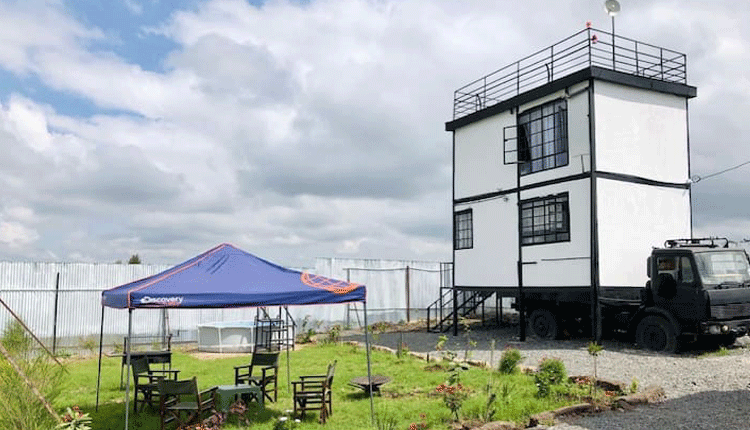How design work impacts tourist habitation choices

Millennials and Generation Z travellers are looking for experiences when travelling. A huge chunk of their income goes to travel, which they consider an investment.
They are looking for unique experiences and are often informed by the internet on what places are open and what experiences are available.
Airbnb, an online marketplace, knows this with most of its listings trying to differentiate themselves from the rest through unique designs.
From geodesic domes in Chile to a redesigned bus in Kenya, travellers can pick the accommodation they would like with design largely influencing their decision.
Testament to just how influential design can be to tourists’ travel experience is the fact that Ian Wafula got the first visitors to his uniquely designed truck house in Machakos, just three days after listing it on Airbnb.
The Truckhouse has slowly picked up with travellers streaming in steadily after its launch on May 3, 2021.
“My truckhouse is an intimate design project that I undertook with my friend who is an architect.
I bought this ex-military truck at an auction and decided to create a unique property from it.
The Truckhouse is a two-storey building designed around the truck. I have always loved tiny houses and thought that a truckhouse would be the best way to do a unique design yet liveable space.
There is a cosy office space that we designed using the truck’s front seats, a kitchen, living room (with a projector for movie nights), bathrooms, a double bedroom, and a plunge pool outside the truckhouse.
The reception has been good with many people, couples, and friends coming to enjoy the facility,” shares Wafula.
Consider environment and community
Further away to the Coast is another property that people frequent for swimming and lunches as well as overnight stays mainly due to its unique room designs. 
Stefano Pelloni, the owner and manager of Rock and Sea Watamu, started the eco-lodge in July 2017.
He built the lodge using natural materials and ensured the lodge designs maintained the sanctity of the natural habitat.
Cognizant of the fact that travellers demand unique experiences, the idea of bubble rooms and uniquely designed standard rooms was born.
“We have three bubble room designs; the baobab bubble that is surrounded by the mangroves, the lagoon bubble, which faces the sea, and the bush bubble, which is surrounded by natural bush trees.
The concept of the bubble is for travellers to enjoy viewing nature from sunset to sunrise.
One can watch the clouds, sky, moon, and stars as the bubbles are transparent on top.
To cap off the nature immersion and amazing coastal experience, we have a traditional dhow that takes visitors around the creek and to the Marine Park,” says Pelloni.
He talks about how the unique eco-lodge design has had a great reception from both domestic and international tourists.
He shares the importance of differentiating one’s product offering in order to serve clients in a new way.
For him, it is not solely about ensuring the eco-lodge offers unique experiences and accommodation.
He is also keen on impacting the local community by sourcing fresh seafood from the local fishermen and providing employment for the local community.
He emphasises the importance of looking at the whole picture when curating unique experiences to ensure that the projects have a positive impact on tourists, communities, and the environment.
While you may think that only new-age designs such as bubbles and truckhouses interest travellers, buildings with a rich heritage are equally irresistible to travellers.
African Heritage House—housing an art collection spanning 50 years from all over Africa—is also a work of art.
The house in Athi River, Machakos county, was designed in the early 1990s by Alan Donovan, an author and African art connoisseur, with the aim of preserving African architectural designs.
Of rich African heritage
The original inspiration for the house is the towering mud mosques of Djenne in Mali, the largest earthen structure in the world, and Swahili architecture of the East African Coast people as seen in coastal towns such as Lamu and Zanzibar.
It is reminiscent of the mud palaces in Morocco and the painted houses of Ghana and Burkina Faso.
The house was gazetted as a national monument in Kenya in January 2016 and is open to the public for daily tours, lunches, dinners, events, weddings, conferences, and bed and breakfast overnight stays.
It has achieved the record of having the best reviews of any of the over 350 B&Bs in Kenya on Trip Advisor.
“I arrived in Kenya in 1970 in my trans-African safari. I had already visited several African countries and was in awe of the culture and architectural knowledge.
I would meet the first Foreign Minister and second Vice President of Kenya Joseph Murumbi, and his wife Sheila, during one of my art exhibitions.
He was very interested in art, so we decided to form African Heritage where we would showcase African art. Some of the pieces we collected are in the African Heritage House.
The house is not just a beautiful accommodation option for tourists. It is also a haven for African art and a place where travellers can learn and appreciate the rich African culture,” intimates Donovan in conclusion.



